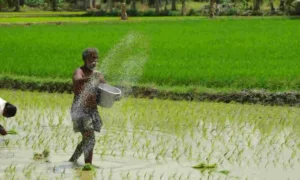India’s rice output is set to decrease for the first time in eight years in the 2023–24 season, affected by scant rainfall.
This forecast comes after India, the leading rice exporter, imposed a ban on non-Basmati white rice exports last July, sparking a surge in global rice prices.
Additionally, officials predict rice production to drop by 8.8% to 123.8 million metric tons by June’s end.
The Ministry of Agriculture and Farmers’ Welfare predicts a decrease in wheat production from 114 to 112 million metric tons.

Global agricultural markets’ interconnectedness highlights national policies’ impact on worldwide food security and pricing.
Why does it matter?
The anticipated reduction in India’s wheat and rice production is significant for a multitude of reasons.
As a leading exporter of rice, India’s decreased output could escalate global food prices, impacting nations dependent on these imports.
The agricultural sector, a cornerstone of the Indian economy that supports countless farmers, could see reduced incomes, impacting rural communities.

